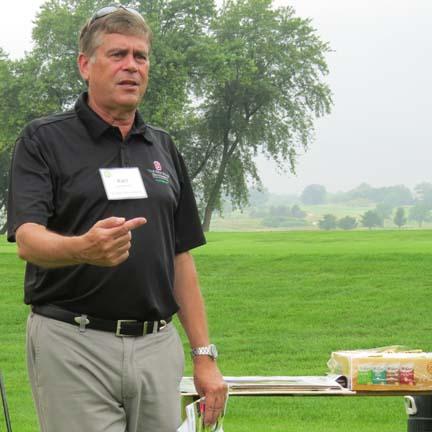 Adverse weather might be blamed for keeping golfers off the course, but about 30 Chicagoland-area superintendents braved threatening skies for the second annual Turf Science Live.
Adverse weather might be blamed for keeping golfers off the course, but about 30 Chicagoland-area superintendents braved threatening skies for the second annual Turf Science Live.Held at the Merit Club in Libertyville, Illinois, Turf Science Live is a multi-station field day demonstration that allows superintendents to get up close and personal and kick the tires on some recent offerings from Syngenta, Jacobsen, Smithco and Turfco.
The eight-station field day included information on new products as well as preliminary results on bentgrass brushing research being conducted at Ohio State University under the direction of Karl Danneberger, Ph.D. (above).
1. Make Spraying More Efficient, Convenient and Accurate: Jeff Churchill, Smithco
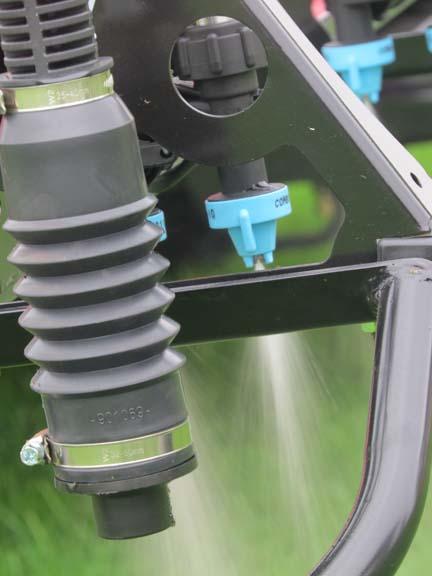 Smithco displayed its aptly named Sharpshooter Capstan system at this year's Turf Science LIve.
Smithco displayed its aptly named Sharpshooter Capstan system at this year's Turf Science LIve.Used in agriculture for many years, this technology from Smithco combines two nozzles and a solenoid at each nozzle location, allowing users to deliver 0.40 gallons to 4 gallons of product per 1,000 square feet at an operational range of 2 mph-10 mph.
The nozzles pulse at up to 19 times per second in a staggered opposite pattern designed for improved coverage.
The operator can change spray pressure and sprayer speed to get a larger droplet size and guard against drift in windy conditions.
Some users, according to Smithco, are reporting increased spray efficiency of up to 30 percent.
Keeping the Sharpshooter clean is key in maintaining efficiency.
"Cleaning is an important part of when after you are done spraying. Triple rinse should be practiced by everybody, but not everybody does it," said Smithco?s Jeff Churchill. "For those who have a good cleaning program, I never hear from them. Those who don't clean out their system as often as they should, those are the guys I'm getting calls from."
2. Using GPS to Guide and Control the Spray Vehicle: Steven Johnson, Smithco
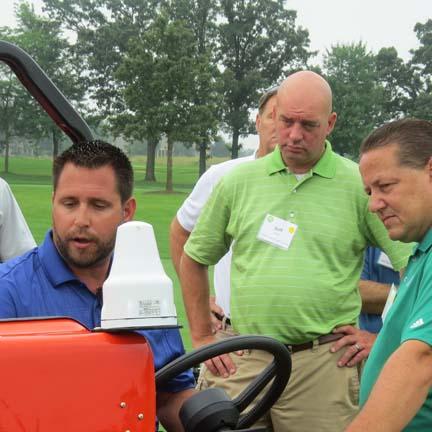 Another holdover from agricultural use, GPS-assisted spray technology helps prevent sprayer operators from applying to much or too little of a given product.
Another holdover from agricultural use, GPS-assisted spray technology helps prevent sprayer operators from applying to much or too little of a given product.Smithco's GPS spray technology allows users to spray with or without a pre-set map. As-applied (no map) lets the operator simply turn on the sprayer and go, while GPS prevents any over-application by shutting down individual or multiple nozzles in the event of an overpass.
"It doesn't change how you spray now," said Smithco's Steven Johnson. "It just doesn't allow you to over-apply when you overlap an area."
Using the zone-mapping feature eliminates overlapping as well as missing an area completely. Nozzles will shut off if the operator goes outside the zone, and only the nozzles that are needed will be activated if the driver passes over skipped areas.
Smithco does recommend completing the job within 20 minutes of creating the map because of potential interference with the GPS signal as well as any shifts of the map due to slight orbital deviations in a satellite?s geosynchronous orbit.
"If you wait more than 20 minutes," Johnson said, "that map can shift up to a few inches."
3. Greens Brushing - When Does Physiological Stress Occur? Karl Danneberger, Ph.D., Ohio State University
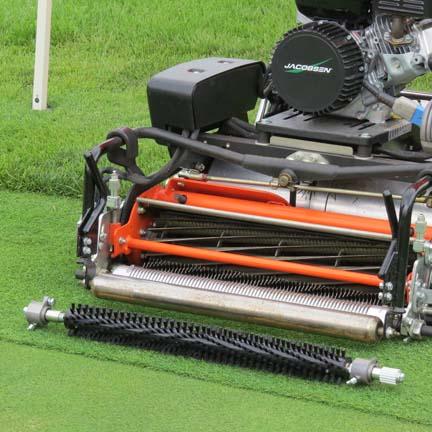 When the USGA approached Ohio State's Danneberger last fall about starting a study on the effects of brushing on creeping bentgrass greens, he never thought it would be so difficult to produce damage turf.
When the USGA approached Ohio State's Danneberger last fall about starting a study on the effects of brushing on creeping bentgrass greens, he never thought it would be so difficult to produce damage turf.The study measures the effects of using a soft Jacobsen brush out in front of a walk mower. The Penncross plots are mowed six days a week at a height of 0.125 inches. One area is brushed once per week and another three times per week, with the brush set at 0.1 inches.
The brushed plots exhibit improved turf quality, rolling at about 12 on the Stimpmeter, and are healthier.
Even during times of high stress (with the Poa patches in the bentgrass showing signs of anthracnose) brushing hasn?t produced any damage. Danneberger has gone so far as to recently increase brushing up to five times per week with no negative effects, and will soon incorporate a medium brush into the trial at the OSU turf research facility in Columbus.
Not only does brushing help stand up the turf plant, says Danneberger, it also helps remove some of the organic matter.
4. Dialing in Frequency of Clip: Chris Fox, Jacobsen
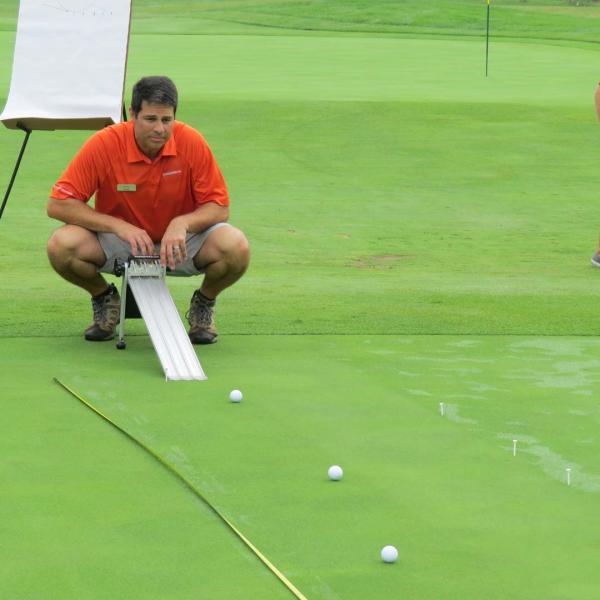 Increasing frequency of clip, says Chris Fox of Jacobsen, is almost like double-cutting in a single pass.
Increasing frequency of clip, says Chris Fox of Jacobsen, is almost like double-cutting in a single pass.A measure of distance defined as how far the bedknife moves before another reel blade passes over it, frequency of clip is dependent on three factors, number of blades on a reel, reel speed and the walking speed of the operator (or rolling speed of a triplex).
First, it's important to get your hands around the idea that when discussing frequency of clip, a smaller number means increased frequency of clip. Using a reel with more blades, increasing reel speed rpm or operator speed can increase frequency of clip.
Fox (pictured here) used a Pelzmeter to demonstrate the effect of increased frequency of clip on putting conditions and turf quality on a Merit Club practice green.
While increased frequency of clip typically is a good thing when going from one side of the green to the other, it can be problematic in turns and on cleanup passes, where a high rpm rate in turns can produce turf stress.
Jacobsen is a pioneer in variable frequency of cut, which slows reel speed when the mower slows down on turns.
"When you slow down on a cleanup pass, it slows the reels also," Fox said. "They're not spinning too fast, and you don't get that burned look."
5. Maximizing Turf Performance and Stress Tolerance: Matt Giese, Syngenta
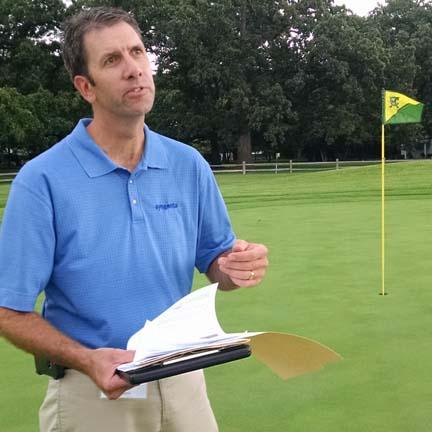 There are many fungicide products on the market today touting benefits that produce results like a fertilizer or other nutritional product. In fact, the term "plant health" has become ingrained in the turf maintenance vernacular.
There are many fungicide products on the market today touting benefits that produce results like a fertilizer or other nutritional product. In fact, the term "plant health" has become ingrained in the turf maintenance vernacular.Matt Giese of Syngenta explained how some of these products work, and pointed to a Merit Club practice green as well as turf maintained at fairway heights that are part of a Syngenta fungicide program as proof.
Giese explained at virtually all strobilurin fungicides exhibit some plant health benefits, ranging from increased water use efficiency, increased levels of chlorophyll in the plant tissue, improved photosynthesis or a more well-developed root mass that reaches deeper into the soil profile.
Syngenta's entry into the plant health arena, Daconil Action, combines chlorothalonil along with a plant activator called Acibenzolar-S-methyl. If poured directly onto turf stricken with anthracnose, brown patch or dollar spot, Acibenzolar-S-methyl would do nothing. What it will do is trigger the plant?s inherent defense mechanisms.
"It gets the disease from the inside and the outside, from the chlorothalonil and the plant activator," Giese said.
6. Turf Application on Target: Luke Dant, Syngenta
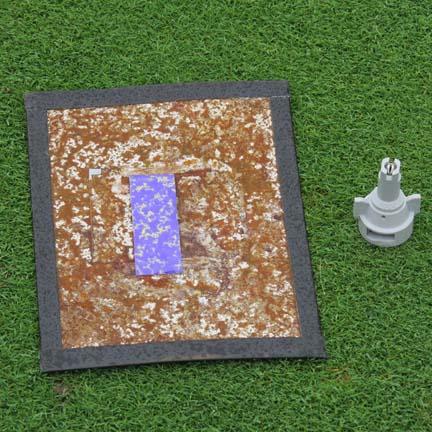 How a product is applied to turf is, according to the folks at Syngenta, almost as important as what is being applied.
How a product is applied to turf is, according to the folks at Syngenta, almost as important as what is being applied. To maximize product efficacy, it is important to get as much product on the leaf blade as possible. That means selecting a nozzle that gets as much product as possible onto as many individual leaf blades as possible. Properly calibrating and setting up a sprayer as well as selecting the right nozzle all are key parts of the equation.
The proper nozzles, such as those from Syngenta's XC line or TeeJet Technologies' TeeJet (pictured here), maximize coverage and help a superintendent?s bottom line. The rear-facing 06 air-induction nozzle creates an air bubble inside the nozzle that increases the droplet size to reduce drift.
Syngenta?s Luke Dant was able to show this during TSL by driving a sprayer over specially treated paper that changes color when it comes into contact with, in this case, water. Dant?s demonstration came just before a violent thunderstorm rolled in. Preceded by strong sustained winds and even stronger gusts, the air-induction nozzle outperformed other nozzles in the test by reducing drift when delivered at 50 psi and even 30 psi.
7. Precision Topdressing: Scott Kinkead, Turfco
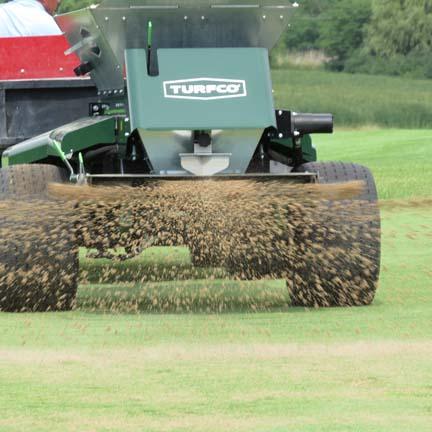 In the past, golfers weren't the only ones who had a reason to gnash teeth whenever it was time to topdress. Equipment operators didn?t much like it either, because
In the past, golfers weren't the only ones who had a reason to gnash teeth whenever it was time to topdress. Equipment operators didn?t much like it either, because
different application rates for different parts of the course often meant doing greens one day and tees another. No more.
The Wide Spin 1550 topdresser from Turfco comes equipped with a handheld digital controller into which operators can pre-program up to four different application rates. That means the equipment operator can go straight from a green to the next tee and change sand application rates with the
click of a button.
And with a hopper measuring 80.5 inches wide, the 1550 has what Scott Kinkead says is the industry's widest hopper.
It also can distribute sand at up to 15 cubic feet per 1,000 square feet.
8. Increasing Seeding Success: George Kinkead, Turfco.
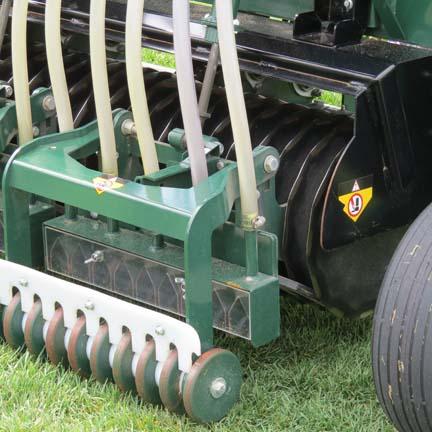 Slit seeding is a great way to establish turf - when it works, says George Kinkead of Turfco. Problem is, according to Kinkead, it doesn't work as well as it should - until now.
Slit seeding is a great way to establish turf - when it works, says George Kinkead of Turfco. Problem is, according to Kinkead, it doesn't work as well as it should - until now.The problem with slit seeding in the past, Kinkead said, is that seeders cut V-shaped grooves that don?t catch enough seed and don't result in sufficient seed-soil contact. Turfco's Triwave 40 seeder features wave-shaped discs that cut flat-bottomed grooves. These grooves catch more seed (leaving less on the surface, resulting in seed-soil contact that outpaces V-shaped slits.
Research conducted by Grady Miller, Ph.D., at North Carolina State University shows that slit seeding with the Triwave 40 results in a 30 percent higher germination rate and a germination rate that after two weeks is 50 percent higher than that realized with other machines. The secret, along with the flat-bottomed groove, is a distribution box that helps distribute seed where it is needed, casting aside what Kinkead called the scatter and hope process.

